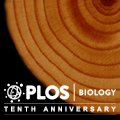We Have the Technology…
“Gentlemen, we can rebuild him. We have the technology. We have the capability to make the world’s first bionic man. Steve Austin will be that man. Better than he was before. Better…stronger…faster.”
Readers of a certain age will tingle with recognition at those words, intoned over the intro to ’70s TV series “The Six Million Dollar Man“, promising the bodily reconstruction of a seriously injured astronaut. Back then it was distant science fiction, but fast-forward 30 years to 2003, and a very shiny new PLOS Biology published a paper in its second ever issue that did indeed “have the technology”.
First author Jose Carmena recalls the thrill of getting involved in a new model of publishing: “The open access idea was really exciting yet there was the risk and uncertainty of publishing in a new journal, especially as my paper came out in the second issue so there was still very little information available and lots of questions about the future of open access publishing in general and that of PLOS in particular.”
 In “Learning to Control a Brain-Machine Interface for Reaching and Grasping by Primates”, Jose Carmena, Miguel Nicolelis and colleagues described an astounding experiment that brought Steve Austin’s bionic arm closer to reality. Using monkeys with large numbers of electrodes implanted into broad swathes of their cerebral cortex, they recorded the activity of numerous neurons while the animals learned to perform a simple task of gripping and pushing a pole to reach and grasp a virtual object on a screen. The neuronal activity data were fed into a computer and used to develop a model for real-time prediction of the monkeys’ arm movements.
In “Learning to Control a Brain-Machine Interface for Reaching and Grasping by Primates”, Jose Carmena, Miguel Nicolelis and colleagues described an astounding experiment that brought Steve Austin’s bionic arm closer to reality. Using monkeys with large numbers of electrodes implanted into broad swathes of their cerebral cortex, they recorded the activity of numerous neurons while the animals learned to perform a simple task of gripping and pushing a pole to reach and grasp a virtual object on a screen. The neuronal activity data were fed into a computer and used to develop a model for real-time prediction of the monkeys’ arm movements.
So far, so what? But then the authors played a trick on the monkeys. First they disconnected the pole and instead used the output of their computer model to drive the grasper on the screen. After an initial drop in performance, the monkeys soon learned to perform the task using their neurons alone – a true brain-machine interface. For some of these tasks the monkeys controlled a real robotic arm, making it squeeze a spongy object. Finally the authors took the pole away and found that the monkeys didn’t even try to use their arm muscles. Incredible. I’m guessing they did much the same thing with Steve Austin.
You can read the paper itself, or the accompanying Synopsis, for further details of how the authors studied what was going on in the monkeys’ brains. This early PLOS Biology paper has gone on to influence many subsequent studies, being viewed 53,850 times and cited 527 times to date. Our editorial board member Gerry Joyce describes it as “a mind-blowing paper that shows the breadth of PLOS and captured much attention in both the scientific and popular press.”
Carmena had just moved from robotics and engineering, and this was his first neuroscience paper. He remembers the study fondly: “Those years at Duke were were very intense and extremely rewarding. I had the privilege to work side by side with my mentor, Miguel Nicolelis, with whom I learned a lot. The scientific atmosphere and collegiality in his lab was simply remarkable, it really felt like a big family.”
“The impact that this paper had in my career is huge, it basically gave me my dream job in Berkeley,” he adds. Carmena returned to PLOS Biology six years later to publish a further study that explored the long-term process of learning neuroprosthetic control in greater detail, the first paper from his own lab, and one that he feels helped him secure tenure.
Of course, just because they had the technology, it didn’t mean that we did, as Carmena recounts: “A couple of days after the paper came out I remember that Hemai Parthasarathy (our editor) told us that the servers at PLOS had collapsed because of the amount of traffic and downloads of the paper!”
 See the Tenth Anniversary PLOS Biology Collection or read the Biologue blog posts highlighting the rest of our selected articles.
See the Tenth Anniversary PLOS Biology Collection or read the Biologue blog posts highlighting the rest of our selected articles.

Carmena JM, Lebedev MA, Crist RE, O’Doherty JE, Santucci DM, Dimitrov DF, Patil PG, Henriquez CS, & Nicolelis MA (2003). Learning to control a brain-machine interface for reaching and grasping by primates. PLoS biology, 1 (2) PMID: 14624244

